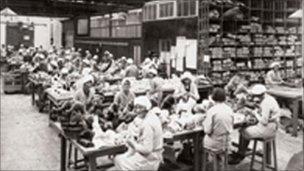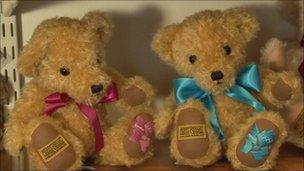Britain's last surviving teddy bear factory
- Published
Oliver Holmes: 'We enjoy an increasingly buoyant market in Japan'
What could be more British than a teddy bear?
Childhood favourites, Winnie the Pooh and Paddington Bear are as British as tea on the lawn or a rainy bank holiday.
Although teddies were invented in Germany and the US in 1902, it was the British who took the teddy bear to their hearts and opened bear making factories all over the country.
But by the end of the 20th Century, they could not compete with the cheap bears imported from China and most of them closed down.
Of all the 30 or so teddy factories that once existed in Britain, only one still remains. Nestled in the Shropshire countryside, Merrythought Ltd has been making bears since 1930.
Occupying an old foundry on the banks of the Ironbridge gorge, the Merrythought factory looks like a relic of a by-gone age.
Inside, a dozen or so ladies hand-stitch each teddy in much the same way as was done 100 years ago. The only real difference is the addition of a mechanised stuffing machine.
How to make a teddy bear
The company makes bears to order and keeps a huge stock of material ready to cater to every possible taste.
On the upper level of the foundry, below the glass ceiling, stand row upon row of rolls of brightly-coloured fabric.

Merrythought has been making teddy bears for decades
They have every imaginable shade of brown - coffees, caramels, golds and chocolates. Each piece of fabric has a different feel: there is very soft angora and shaggy mohair, velvets and synthetic pile.
Once the material has been chosen, it is taken down to Leslie Hunnisett, who cuts out the arms, legs and heads.
She uses what look like a series of giant cookie-cutters to cut each shape: ''This is probably the 218th ear I've cut out today," she laughs.
The parts then go to the machinists, who sew them together so the teddies can start to take shape.
Once that is mastered, the limbs are sent over to Pauline Davies who puts the eyes on.
Health and safety rules mean teddy bear eyes are no longer made of glass, but Pauline has drawers and drawers of painted, plastic eyes of all sizes to choose from.
The teddies are then sent over to Sharon Taylor, who operates the huge, noisy stuffing machine.
She places the limbs over a pipe and operates a pedal to fill each saggy limb with stuffing.
The result is baskets full of dismembered teddies with stuffing protruding out of their limbs. Luckily, they do not stay that way for long. Abi Summers quickly puts joints in each of the limbs and sews them up.
The bears now begin to look more complete and they go to Penny Reeves, who sews on their noses and mouths. The snouts are made from a tougher fabric and getting the needle through - and in the right place - can be difficult.
No-one wants a grumpy-looking teddy bear, so making sure the stitch falls in the right place is vital. "You sew down the middle first, then do one on the outside, then the other side and you keep building it up," says Penny.
Before the bears can be packaged up, they need to be groomed by Wendy Edwards. She trims away excess material from the eyes and brushes each teddy's fur ''so you can see the eyes and the smile".
With a flourish, she ties a ribbon around its neck and the teddy is finished.
'Cult in Japan'
Oliver Holmes, the managing director of Merrythought, acknowledges that his bears are far more expensive than others on the market.
The average price of a soft toy in the UK is £7.81 and the smallest Merrythought bear retails at well over £50.
How to make a teddy bear
Clearly the price tag does not put people off, as the company produced more than 30,000 bears in 2010. But just who is buying them?
Part of the customer base is made up of collectors, but more than 50% of their teddies are exported to Japan, where Mr Holmes says a range of Merrythought bears have ''developed a cult following''.
The Japanese market has sustained the company over the past few years and Mr Holmes says the weakness of the pound against the yen means "our products in Japan are even more sought after, because the prices have been maintained".
The company works hard to retain its Japanese market and visits the country twice a year to give teddy bear-making demonstrations in big department stores.
It is mainly thanks to the huge revenue that the Japanese market provides that Merrythought has stayed open in the face of competition from cheaper imported toys from East Asia.
Olympic merchandise
The decline of British toy manufacturing does not seem to have harmed the UK toy industry as a whole. Toy sales rose by 6% in value and 9% in volume in 2010, according to the retail tracking group NPD.
The British Toy and Hobby Association (BTHA) values the industry at an estimated £2.83bn, heralding a return to pre-recession value. Even in an age of electronic games, demand for traditional and retro toys continues.
NPD found that in 2010, the fastest growing toy categories were building sets and plush toys (including teddies) which grew at 39%.
However, Christine Nicholls, chairman of the BTHA, predicts that 2011 may be tough for the industry as people start to worry about the possibility of losing their jobs and the impact of the VAT rise.

The classic teddy bear has been given an Olympic twist
"Creativity, resilience and relevance have all played their part in helping the toy industry to weather the past two years," she says.
"The economy over the next 12 months will be difficult for many people in the UK and the industry needs to maintain its focus on producing toys with great play value at affordable prices," she says.
Toys inspired by blockbuster films proved particularly popular in 2010, with characters from Toy Story 3 bringing in the most revenue.
This trend for fashionable soft toys has led many businesses to take advantage of the forthcoming Royal Wedding and the 2012 Olympics.
Official London 2012 merchandise will contribute approximately £80m to the staging of the games and will no doubt generate huge amounts of publicity for the companies involved.
Merrythought is one of the businesses supplying 2012 products and Mr Holmes hopes it will mean "we can make Merrythought products available to a slightly wider and more discerning audience'' and keep the company going for another 80 years.